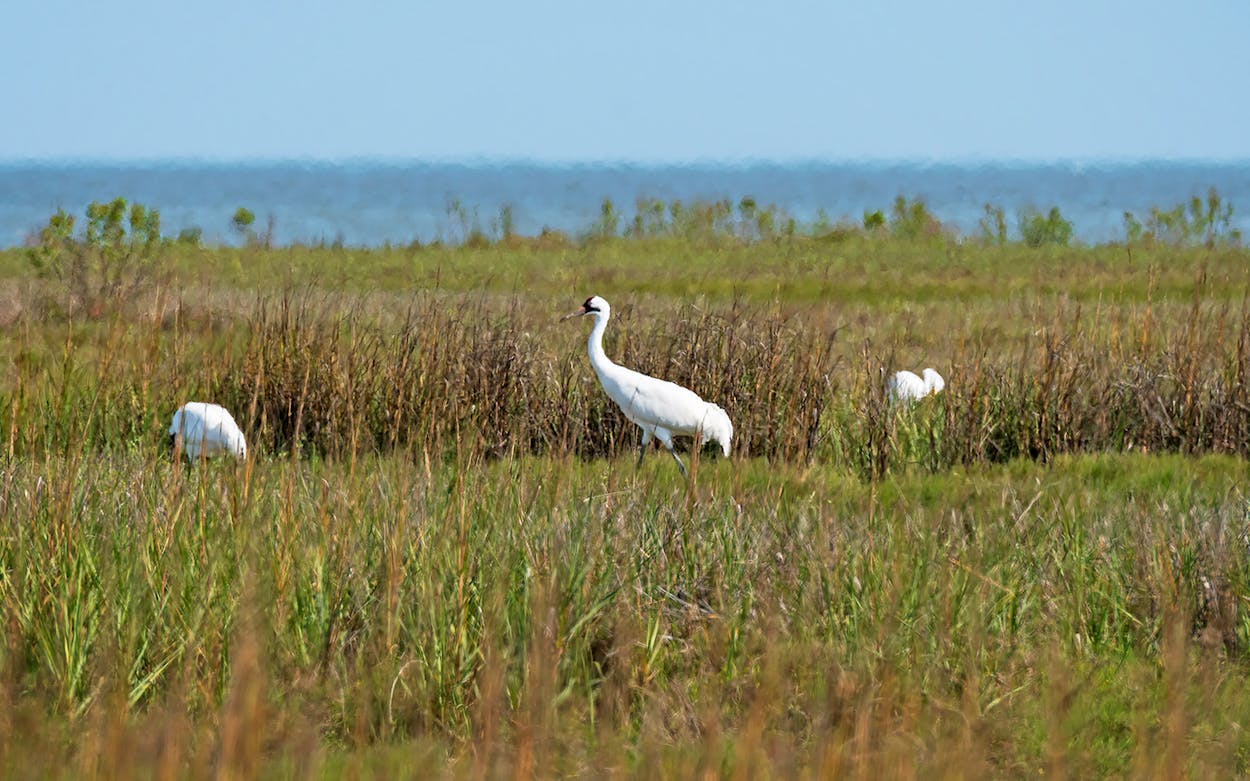WHO: Two pairs of whooping cranes, one of the world’s most endangered birds.
WHAT: The animals are laying eggs in Texas—on private land in Jefferson and Chambers counties, east of Houston—for the first time since the late 1800s.
WHY IT’S SO GREAT: Every fall, the world’s last self-sustaining migratory flock of wild whooping cranes descends on the marshes of the Aransas National Wildlife Refuge. One of only two crane species native to North America, the whooping crane is the continent’s tallest and rarest bird: five feet high with crisp white feathers, a red-capped head, and a ratcheting, mournful call. The wild flock’s 506 birds spend the winter in the 115,000-acre refuge, fattening up on blue crabs, clams, and fish, before traveling back to northern Canada to breed.
Birders from across the globe travel to Port Aransas every winter, seeking a rare chance to see whoopers and other migratory species. There’s even a Whooping Crane Festival each February (though it was scuttled this year due to the pandemic). But until now, the birds were just passing through. As the U.S. Fish and Wildlife Service announced this week, two pairs of whooping cranes are nesting in Texas for the first time in more than a hundred years.
These four birds aren’t part of the Aransas flock; instead, they’re from a nonmigratory population that was reintroduced to Louisiana’s White Lake Wetlands Conservation Area in 2011. They’ve built their nests on private land in Chambers County, roughly an hour east of Houston and four hours northeast of the Aransas refuge. For environmentalists, their presence is a hopeful sign that the endangered species is making a comeback.
Whooping cranes have had a rough time on the Gulf Coast since the mid-1800s. Never very common compared to the sandhill crane, they are slow and careful breeders. “They don’t reproduce until they’re five to seven years old, and they only have one or two eggs that make it every couple of years,” said Liz Smith, North America program director at the International Crane Foundation. “So it takes a long time for them to increase their numbers.” As a result, the birds suffered badly from unregulated hunting, while their breeding grounds were converted to cropland across the continent. By 1941, only sixteen birds were left in the wild.
In the years since, intensive conservation and captive breeding efforts have managed to raise the bird’s numbers to around 800 animals split between four populations, including the wild flock at Aransas and a migratory population in Florida established in 2001. For whooping cranes, migration is a complex and highly specific practice: parents lead their chicks through established routes, stopovers, and specific winter grounds. Remarkably, conservationists have managed to establish new migratory flyways by training young, captive-bred birds to follow an ultralight aircraft from Florida to new nesting grounds in Wisconsin, with the new parents teaching the route to their chicks in turn. (It’s not all good news, however: poaching of cranes continues to be a problem, accounting for more than 15 percent of population losses in Louisiana.)
The Louisiana flock, however—which now numbers around 76 birds—is replacing a population that did not migrate to breed, and there are no plans to encourage migration, according to Smith. For conservation purposes, it’s useful to have a population of birds that doesn’t regularly make a strenuous and dangerous trip of several thousand miles. “But they do wander,” Smith said. “They’ve gone as far as the Dallas–Fort Worth area, and of course, they don’t recognize borders. So now some of them are settling in East Texas.”
Over the past few years, around two or three mated pairs have been visiting private land in Jefferson and Chambers counties. This year marks the first time any of them has created a nest—a piled mound of trampled reeds and sedges—and laid eggs, which take thirty days to hatch. Of the two nests announced by U.S. Fish and Wildlife, one chick has emerged, though it didn’t survive. The other egg, Smith said, has yet to hatch.
While that might sound like a discouraging result, it’s actually fairly normal: parenthood is a high-stakes game for cranes, and it takes time to learn. “I would say inexperience had something to do with this. These birds don’t start laying eggs and successfully raising young until they’re five to six years old,” Smith said. “We wouldn’t expect them to be successful on their first attempt.”
In the meantime, the simple fact of the nests’ existence is cause for celebration, even if it marks the start of a long process of figuring out how to accommodate these new and extremely wary parents. While birders might be tempted to flock to the location to see the nests, both U.S. Fish and Wildlife and Smith emphasize that it’s vital not to disturb the birds. In the meantime, however, the International Crane Foundation, U.S. Fish and Wildlife, and Texas Parks and Wildlife have been working with the anonymous landowners to figure out how they can minimize any human impact on the cranes. If all goes well, one day the mournful whoop of resident cranes will echo over the marshes of East Texas, as it did more than a century ago.
“This has been a really good situation,” Smith said. “Perhaps the best possible one.”
- More About:
- Critters
- Best Thing in Texas
- Port Aransas
- Houston






